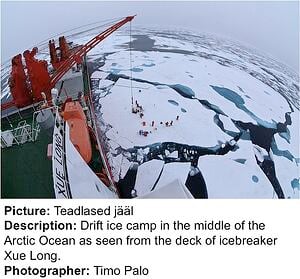Recently the first Chinese merchant vessel reached the Atlantic from the Pacific via the North East Passage. This is a major international shipping breakthrough for China and could result in lower freight rates.
 The North East Passage is a dangerous trading lane to say the least. The route requires a cargo ship be equipped to break up thick Arctic ice–quite the challenge. AFP reported that China met that challenge and traversed the North East Passage.
The North East Passage is a dangerous trading lane to say the least. The route requires a cargo ship be equipped to break up thick Arctic ice–quite the challenge. AFP reported that China met that challenge and traversed the North East Passage.
The Chinese tanker named Xuelong (Snow Dragon) made the voyage from the coast of China north through Arctic seas to its destination in the cold northern waters off Iceland.
The Snow Dragon is really more of a research vessel than a cargo vessel, but it brings China’s international shipping within striking distance of offering exports from the country a much shorter, alternative route.
The Snow Dragon is China’s only ice breaker according to the AFP. But there will be more to come, especially, as the article says, since the Chinese “found the passage relatively easy.” It could have a strong effect on ocean freight rates from China or at least on their ocean freight profit as shipping distances are significantly shortened
Since ancient times Europeans have been engaged in trade with the Far East. The silks and spices available only in Asia were eagerly sought by western Europeans. Initially, it was the overland route called the ‘silk road’, a long and dangerous route overland from the Far East to the Eastern Mediterranean, which provided access to the wealth of the east for markets in the west. Easterners generally controlled the trade, and the commodities flowed from east to west.
As western nations in the Middle Ages improved their shipbuilding techniques, western merchants sought a more active role in the east-west trade. Instead of waiting for eastern merchants to transport expensive goods over laborious and dangerous over-land routes, European mariners began experimenting with alternate sea routes to Asia. This meant sailing around Cape Horn and across the Indian Ocean all the way to the coast of China and the islands of Indonesia. However, this long sea route also harbored dangers and took many months to complete, especially during monsoon season when the Indian Ocean was impassable.
As early as the 1500s, European explorers sought long and hard for an alternative route. They wanted a route that would shorten the ocean freight trip between Asia and Western Europe. The North East Passage allowed merchant cargo vessels just that. It was a shorter, swifter route by allowing ships to head north from China, hugging the Kamchatka peninsula, continuing along the icy Siberian coast, and eventually making their way to northern European shores.
Explorers worked on completing the voyage from both ends, Russian explorers working their way between Siberia and Asia, while nautical adventurers from northern European nations like Denmark, Norway, and England struggled through the ice from the West.
It wasn’t until 1878 that the Vega finally made the complete passage from west to east.
Polar ice has made the route difficult to traverse but with the combination of icebreaker vessels and climatic changes that reduced the Arctic ice, it has become easier for cargo ships to utilize the northern route.
Despite the cold and dangerous icebergs in the waters of the North East Passage, the route is worth the higher insurance for one big reason. It is 40% shorter than the alternative southern route from China, around South East Asia, up the Red Sea and through the Suez Canal, through the Mediterranean Sea, the Straits of Gibralter, and on to the northern European coast.
This incredible drop in distance has finally induced China’s international shipping into the North East Passage.
The savings brought China into the Arctic waters with the Xuelong vessel. It is the first, but won’t be alone by 2014 according to the AFP article. More ships equipped to deal with thick Arctic ice will launch from the coasts of China and have a significant impact upon international shipping rates.
Call 866-826-2276 now for shipping freight rates from China!
